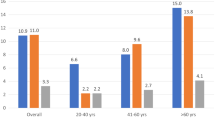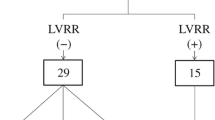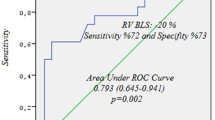Summary
Patients with dilated cardiomyopathy (DCM) generally have an impaired functional capacity and poor long-term outcomes. A mortality of 5–15% per year has been described actually. Aim of this study was to verify the prognostic relevance of invasive and non-invasive parameters of diastolic function in patients with DCM. In 33 patients with DCM, cardiac catheterization was performed and left ventricular systolic (ejection fraction (EF; %)); left ventricular enddiastolic pressure (LVEDP; mmHg) and diastolic function (time constant of relaxation (T, ms); the constant of myocardial stiffness (b) were derived from biplane laevocardiography and simultaneous micromanometric registration of pressure-volume curves. For evaluation of clinical out-come, the follow-up period was defined as beginning on the day after cardiac catheterization and ending on the most recent date or with a cardiac event (death or cardiac transplantation). All patients were reevaluated for NYHA functional class and completed a standard questionnaire. The following hemodynamic parameters were evaluated: invasive parameters of left ventricular diastolic function (constant of relaxation: tau (ms), constant of myocardial stiffness: b)), as well as parameters of systolic function (ejection fraction (EF; %)), left ventricular pressure (LVEDP; mmHg), left ventricular muscle mass index (LVMMI; g/m2), left ventricular enddiastolic volume index (LVEDVI; ml/m2) and non-invasive parameters of morphological data, left ventricular systolic (fractional shortening (FS, %) and ejection fraction) and diastolic parameters with echocardiography. During the follow-up period of 36 months, 11 of 33 patients experienced a major cardiac event (cardiac death n=8, heart transplantion n=3). The major cause of death was progressive pump failure. The remaining 22 patients were further classified with respect to changes in functional status. While clinical symptoms could be improved medically in patients with moderate increase of myocardial stiffness, patients with severe increase of myocardial stiffness (b: 76.1±12.1 vs 17.9±+8.1, p<0.001) could not be improved and suffered more cardiac events. Doppler echocardiographic measurements in these patients showed a restrictive filling pattern (VE 0.91±0.21 vs 0.64±0.18 m/s; p<0.01; VA 0.52±0.23 vs 0.57±0.24 m/s; p<0.01, deceleration time 129±17 vs 211±14 ms; p<0.01). The medical heart failure therapy was comparable in both groups. In patients with cardiac events, the diastolic left ventricular variables did not significantly differ between patients who underwent heart transplantation and those who died. Patients who demonstrated a sole impairment of relaxation (tau: >50 ms) suffered no cardiac events. Impaired diastolic function contributes to the clinical picture of congestive heart failure. Parameters of left ventricular diastolic function are powerful and important predictors of major cardiac events in patients with DCM, like heart transplantion and non-sudden death, and may indicate future clinical success of medical treatment. Invasive and non-invasive parameters of diastolic function reveal comparable information for the estimation of prognosis of patients with DCM in order to initiate early therapy.
Zusammenfassung
Die dilatative Kardiomyopathie (DCM) fasst Erkrankungen des Herzmuskels mit Verminderung der kontraktilen Funktion und Vergrößerung der Herzhöhlen zusammen. In neueren Studien wurde über eine Mortalität von 5–15% pro Jahr berichtet. Ziel unserer Untersuchung war die Analyse invasiver und nicht-invasiver diastolischer Funktionsparameter zur Beurteilung der Prognose bei Patienten mit DCM. Insgesamt wurde bei 33 Patienten mit DCM die linksventrikuläre Funktion mittels biplaner LV-Angiographie und simultaner Mikromanometrie erfasst. Vor der Herzkatheteruntersuchung erfolgten eine Einteilung der Patienten nach der NYHA-Klassifikation und eine echokardiographische Ausgangsuntersuchung. Es wurden invasiv gemessene Parameter der diastolischen Funktion (Zeitkonstante der Relaxation: Tau (ms), Steifigkeitsindex: b), sowie der systolischen Funktion (Auswurffraktion (EF; %)), linksventrikulärer Druck (LVEDP; mmHg), linksventrikulärer Muskelmassenindex (LVMMI; g/m2), linksventrikulärer enddiastolischer Volumenindex (LVEDVI; ml/m2) erfasst. Mittels Echokardiographie erfolgte die Bestimmung morphologischer Parameter, systolischer (Fraktionale Verkürzungsfraktion; Ejektionsfraktion) und diastolischer Funktionsparameter. Während der Nachbeobachtungszeit von 36 Monaten starben 8 Patienten an progredienter Herzinsuffizienz, bei 3 Patienten musste eine Herztransplantation vorgenommen werden. Bei diesen 11 Patienten zeigte sich im Vergleich mit den übrigen 22 Patienten in der invasiven Diagnostik ein signifikant (p<0,001) erhöhter Steifigkeitsindex (b: 76,1±12,1 vs 17,9±8,1), eine pathologisch verlängerte Zeitkonstante Tau des isovolumetrischen Druckabfalls (Tau: 59,2±17,3 ms; Normwert 40–45 ms) und dopplerechokardiographisch ein „restriktives” Füllungsmuster mit einem steilen frühdiastolischen Maximum (VE 0,91±0,21 vs 0,64±0,18 m/s; p<0,01) und kleinerem atrialen Füllungsanteil (VA 0,52±0,23 vs 0,57+0,24 m/s; p<0,01). Die Dezelerationszeit des frühdiastolischen Geschwindigkeitsmaximums war deutlich kürzer als bei den Überlebenden (129±17 vs 211±14 ms; p<0,01). Die medikamentöse Herzinsuffizienztherapie unterschied sich in beiden Patientenkollektiven nicht. Bei Patienten mit alleiniger Relaxationsstörung zeigte sich ein benigner Verlauf. Fazit: Sowohl die Zeitkonstante der Relaxation als auch der Steifigkeitsindex sind prognostische Prädiktoren einer erhöhten Sterblichkeit bei Patienten mit DCM. Die Doppler-echokardiographische Analyse des diastolischen Einstromprofils liefert vergleichbare Informationen zur Prognoseabschätzung im Krankheitsverlauf von Patienten mit DCM. Beide Methoden erlauben zum Zeitpunkt der Diagnose die Prognose abzuschätzen und eine entsprechende Therapie frühzeitig einzuleiten.
Similar content being viewed by others
Author information
Authors and Affiliations
Additional information
Eingegangen: 31. Mai 2000 Akzeptiert: 21. Dezember 2000
Rights and permissions
About this article
Cite this article
Schannwell, C., Schoebel, F., Marx, R. et al. Prognostische Relevanz linksventrikulärer diastolischer Funktionsparameter bei dilatativer Kardiomyopathie. Z Kardiol 90, 269–279 (2001). https://doi.org/10.1007/s003920170173
Issue Date:
DOI: https://doi.org/10.1007/s003920170173




